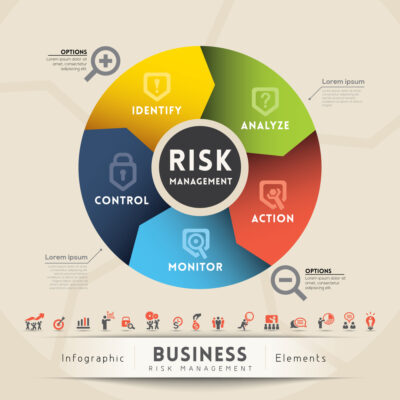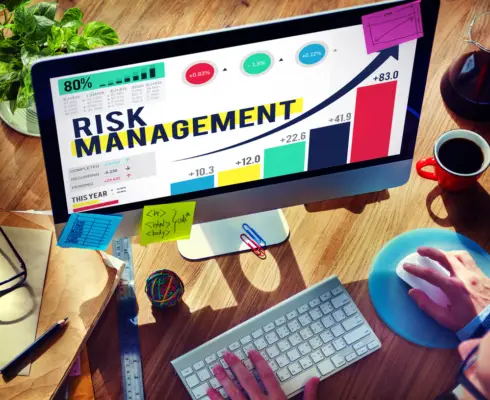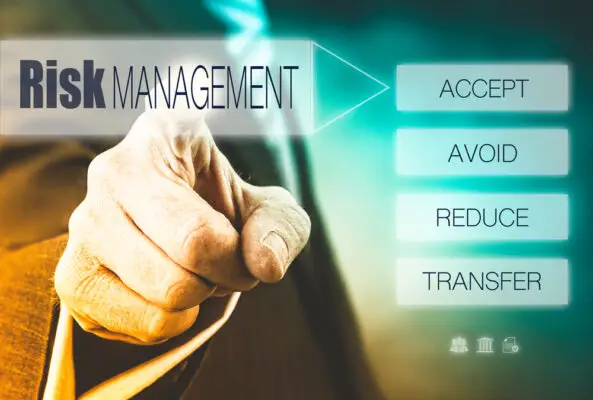Risk management and governance in UX is the process of understanding and mitigating the risks associated with a user experience design. Risks can include usability issues, functional problems, security vulnerabilities, and privacy concerns.
Good risk management practices help ensure that user experience designs are safe, effective, and secure. Enterprise Risk management and risk governance also help ensure that user experience designs are aligned with business goals and objectives. It ensures business processes are aligned with business operations.
Additionally, it is important to ensure that user data is protected and that users feel confident in the security of their information. By establishing clear policies and procedures for managing risk, as well as overseeing the execution of those policies, UX teams can create a safe and secure user experience. Good governance also ensures that user feedback is taken into account when making decisions about the design of the product or service.
In the ever-changing landscape of business, one area that is constantly evolving is the field of user experience (UX) design. As UX designers, we are always looking for ways to improve the user experience by making it more efficient, effective, and satisfying. But with change comes risk.
The importance and benefits of risk management and governance in UX include:-
- Ensure that user experience (UX) projects are planned and executed effectively, with a focus on key business objectives and user needs.
- Identify potential problems and issues early on in the project so that they can be addressed before they become bigger problems.
- Maintain consistency in UX across different channels and platforms, ensuring a cohesive user experience for customers.
- Track progress on UX projects, as well as measure their impact on business objectives and user satisfaction.
In this blog post, we’ll take a look at some of the risks associated with UX design and explore how best to manage and govern those risks.

Risk #1: The Introductory Phase
The first risk we’ll discuss is what we call the “introductory phase.” This is the period of time when a new UX designer is introduced to a company and begins working on projects. During this phase, there is a risk that the UX designer will not be able to effectively communicate his or her ideas to the rest of the team.
This can lead to frustration on both sides and can ultimately jeopardize the success of the project. To avoid this risk, it is important to have a clear understanding of the company’s communication style before beginning any work.
There are a few things that can be done to mitigate the risk of not being able to effectively communicate during the introductory phase. First, it is important to take the time to learn about the company’s communication style. This includes understanding the way that information is shared within the company and how decisions are made.
Second, it is important to be proactive in communicating with the team. This includes sharing your ideas and asking for feedback early and often. By doing this, you will help ensure that everyone is on the same page and that there are no misunderstandings.
Lastly, it is important to be patient and give yourself time to adjust to the new environment. It may take some time for you to feel comfortable communicating with the team and building relationships. Be sure to take advantage of any resources that are available, such as training or mentorship programs, in order to help you succeed.
Risk #2: The Implementation Phase
The second risk we’ll discuss is what we call the “implementation phase.” This is the period of time when a UX designer’s work is actually being implemented by developers. During this phase, there is a risk that the final product will not meet the expectations of the users. This can lead to a decrease in satisfaction and an overall negative experience for the users. To avoid this risk, it is important to work closely with developers throughout the entire process to ensure that everyone is on the same page.
There are a few things that can be done to mitigate the risk of the final product not meeting the expectations of users. First, it is important to have a clear and concise design specification that outlines all of the requirements for the project.
This document should be shared with developers early on in the process so that they can start creating prototypes and getting an idea of what needs to be built. Additionally, regular communication between designers and developers is essential to ensure that everyone is on the same page.
This will help to avoid any misunderstandings or miscommunications which could lead to a disappointing end product.

Risk #3: The Maintenance Phase
The third and final risk we’ll discuss is what we call the “maintenance phase.” This is the period of time after a product has been launched and is being used by users on a daily basis. During this phase, there is a risk that bugs will be found and/or that new features will need to be added.
This can lead to an ongoing cycle of fixes and updates that can be costly and time-consuming. To avoid this risk, it is important to have a plan in place for how you will handle maintenance after launch. This may include setting aside a budget for bug fixes and/or putting together a team of people who can rapidly implement new features as needed.
To mitigate this. First, it is important to have a plan in place for how you will handle maintenance after launch. This may include setting aside a budget for bug fixes and/or putting together a team of people who can rapidly implement new features as needed.
Second, it is important to test your product thoroughly before launch. This will help to catch any bugs that may exist and fix them before users start using the product. Finally, it is important to be prepared for unexpected issues that may arise during the maintenance phase. Having a contingency plan in place will help you to address these issues quickly and efficiently.
Risk Governance
Governance is the process of making decisions about how an organization will operate. It encompasses all of the policies, processes, and standards that an organization uses to ensure that its products and services meet the needs of its users. In the context of UX, governance includes activities such as creating style guides, setting accessibility standards, and developing security policies.
As technology continues to rapidly advance, firms must be proactive about managing the associated risks for users. This is where risk governance for user experience comes in. It involves identifying possible risks, assessing their likelihood and severity, implementing measures to mitigate or eliminate these risks, and monitoring ongoing effectiveness.
By integrating risk governance into the UX design process, businesses can proactively address issues such as privacy concerns, accessibility barriers, and dangerous user interactions.
In a world where technology plays an increasingly central role in our lives, risk governance for UX is essential for protecting both individuals and businesses. It helps to ensure that products and services are not only functional and user-friendly, but also safe and secure.
Enterprise Risk Management
UX professionals may not typically think of themselves as risk managers, but incorporating risk management into the design process can have a significant impact on success. Identifying and addressing potential risks early on can prevent issues down the line and improve overall user experience.
One way to approach risk management in UX is through Enterprise Risk Management, a framework for identifying, assessing, and responding to risks taking into account the larger organizational context.
This can include conducting usability testing to uncover potential problems with the product or service, performing competitor analysis to assess market risks, and considering various stakeholder perspectives throughout the design process. Overall, incorporating Enterprise Risk Management into UX can lead to smarter decision-making and more successful designs.
Managing Risk
Risk management should not be overlooked. Identifying potential risks and mitigating them early on can save time and resources in the long run. This means actively seeking out user feedback, testing prototypes with a diverse range of individuals, and consistently analyzing and improving upon your processes.
It also means being willing to make changes or pivot if necessary, rather than stubbornly sticking to a design that may not work. Of course, no plan is foolproof, so it’s important to have contingency measures in place in case a risk does materialize.
Get it done in UX
A new governance framework design project offers a chance to improve collaboration among digital stakeholders. If a digital strategy is already in place, you need more guidance on how it can be implemented by a large team. You also need to identify risk events only the beginning of the project through the project team.
However, it still requires an information-gathering process from a large number of designers. We believe not only the end states are important, but they are also the conversations, collaboration, and compromise that are essential to the development of your framework. These business process activities are going to help you develop better relationships with other team members.
Starting the Design Effort
Design and leadership teams will be created and the organization announced its governance plans. You have begun your creative project with an active and professional focus. What’s my best method for getting my job completed and what are your expectations?
Because the outcomes of the failure to develop an efficient digital strategy are widespread and pervasive, it is easy to imagine the solution would require much effort over time and also be disconcerting. In fact, it is relatively easy to design frameworks when the designer’s team is inclusive in their approach and the day-to-day operations work takes place in an open spirit.
Team members
Your team of designers should be capable of having meaningful conversations in real-time. So people who can answer questions like: “Do you need a digital transformation plan?” and “Can we change our digital budgets?
Often the management is not properly equipped to handle this type of questions when they have to leave the office for another manager to ask questions. Similarly, if nobody speaks in the room about technology architecture, data analysis, content strategies, and analytics, your organization is lacking resources, then change management needs to be on a day-to-day basis.
Populating the Design Team
Do not underestimate the value of well-supported teams of engineers and designers. The governance design team can sometimes become a strong unit of organization. Sometimes the design team transforms into the digital strategy team.
Leadership is essential to making sure the members are not there for their own interests. Beware of self-chosen Digital governance design teams composed solely of digital teams containing core stakeholder groups as they can easily be viewed as self-served, and their actions are often largely overlooked, despite their merits.

Understand your digital landscape
Many organizations have such digital adversity that they don’t understand the fundamental nature of their digital presence. When you begin to assign accountability and authority, it will take time to gather and analyze the relevant data for your project.
Team leadership
It might take you some time to start building your site. It’s a tough job. How do you want to gain insights into leadership? How should the executive team be helped to understand the message? Through a project communication plan.
It is not possible for this highly specialized professional team to have time for the design work. Digital leadership usually involves a core Internet Team Lead, Marketing Director, CoO, or IT Manager. Board members need to understand the project too and gain their support.
Risk information for the past decade and present is critical to enable the executive team to make informed choices. Understanding the root cause of risk enables the apportionment of effort required to reduce the risk.
Identifying a Sponsor and an Advocate
Digital governance has a lot of organizational complexity but is often defined and rarely implemented by any organization without any sponsors. Therefore, if you don’t have the capability to implement a framework by yourself then ensure you get a person in a position to recommend or implement a change to a digital governance framework.
There are many platforms for new opportunities where innovation and knowledge of companies are offered access. These platforms offer sponsorship for innovative ideas.
Conclusion
Risk management and governance should be considered in any UX design. By understanding the potential risks, you can avoid or at least mitigate them. And by having a solid governance strategy in place, you can ensure that your UX changes are well received and adopted throughout your organization. What steps have you taken to ensure that your UX redesigns are successful?

Chris Ekai is a Risk Management expert with over 10 years of experience in the field. He has a Master’s(MSc) degree in Risk Management from University of Portsmouth and is a CPA and Finance professional. He currently works as a Content Manager at Risk Publishing, writing about Enterprise Risk Management, Business Continuity Management and Project Management.

